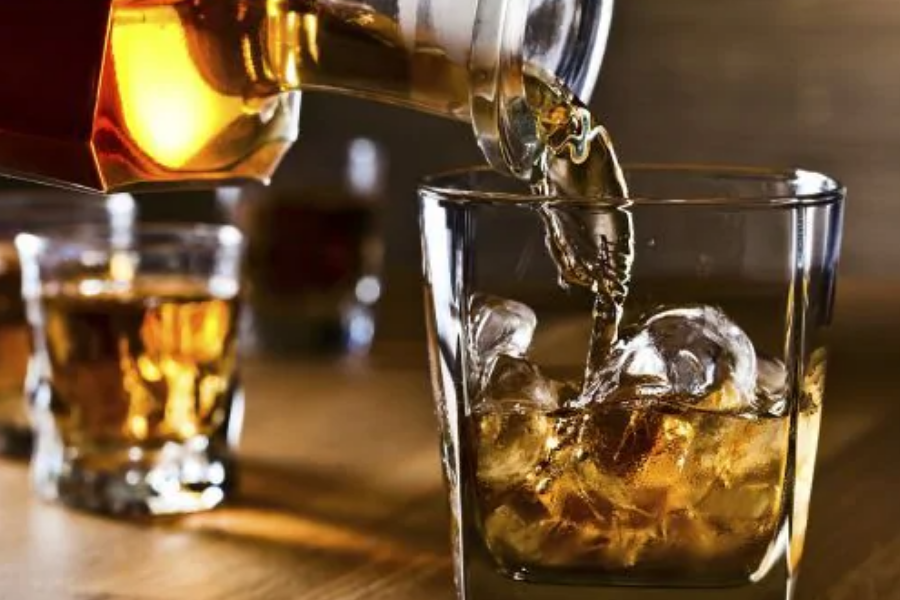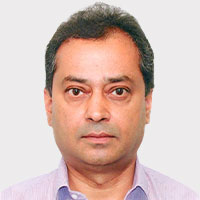Top-end Indian malt whisky compares well to Scotch
Vinod Giri, Director General, Confederation of Indian Alcoholic Beverage Companies believes that while there are clear GI opportunities in India due to raw material (local grains, sugarcane, Kashmir hops, spices), climatic conditions, geographic provenance (e.g. Himalaya, Nilgiris), product (fenny, toddy) etc., it needs strong support from the Government. GIs are difficult to build without consistent and vocal Government support in world trade bodies and on regulatory matters.

Photo Credit: NDTV
IBT: How do you view the size and potential of the Indian alcohol market? Which are the most lucrative segments for alcohol companies and why?
Vinod Giri: The current annual Indian alcoholic beverages market is around 680 million cases (9 litres each) including spirits, beer and wines, out of which the market accounts for 220 million cases (Source: IWSR 2020). Over the next 4-5 years, the Indian alcoholic beverage market could achieve an annual sales volume of 800 to 850 million cases. The COVID-19 pandemic could, however, play spoilsport with any forecasting.
In terms of volume, the regular (Officer’s Choice) and deluxe (McDowell’s No 1) are the largest segments (in the price range of ₹250 to ₹400 per 750 ml bottle) comprising over 40% of the spirit alcohol volumes though the margins are relatively thinner. Many companies consider the middle segment (Rs 500 – 700 per 750 ml bottle) as a good balance between margins and volume.
*Price reference are for Delhi
IBT: India is regarded as the largest consumer of whisky in the world? What are the factors driving the growth in the market?
Vinod Giri: The tradition of whisky goes back to colonial times and British influence. While it has remained the most prominent segment, its offer of wider product quality and pricing choices to consumers has helped it retain the top position. Whisky has developed a widely perceived quality association due to frequent and visible use of experience enhancement measures such as ageing and maturing.
India has currently over 850 million people in the legal drinking age. There is growing acceptability in society with respect to consumption of alcohol that has been brought to the fore by greater international exposure and the growing population of millennials. The proliferation of nuclear families has increased consumption in urban areas and also contributed to a significant increase in women consumers in the metros.
Certain state governments have liberalised excise rules and have made available liquor in malls and departmental stores, thereby allowing discerning consumers to shop in ambient environments. All this has contributed to sustained growth of the industry.
IBT: How does IMFL fare in comparison to scotch in India? What is the potential of malt spirit in India?
Vinod Giri: IMFL is an umbrella term and covers a wide range of spirits from very high quality aged malt whiskies to entry level and highly accessible products. The bulk of the segment is a blend of Indian spirits and imported whiskies and is cheaper than Scotch in India. It also is massive in size compared to scotch, being over 240 million cases compared to little over 4 million for Scotch (both imported and bottled in India).
Top end IMFL products like malt whiskies, are in relatively early days of product cycle and whilst they compare very well with leading Scotch products in quality, they are yet to build the demand traction that Scotch whiskies have built over decades.
Malt whiskies are picking up well in India with the rise in incomes, upward social mobility and increased availability of new malt-based whiskies of good quality. Both imported and Indian malt spirits are growing very well, though from a relatively small base.
IBT: Origin whiskies like Bourbon and Scotch have made a strong mark in the international market. What are the key factors behind their success and firmly established premium value proposition in the market?
Vinod Giri: Bourbon, Scotch or some other such origin products are helped by a long history, good product quality, consistent marketing highlighting quality and provenance, and low cost of production due to scale that their operations and local laws permit. They are also consistently and overtly supported by their Governments as we see in trade negotiations.
IBT: What are the unique origin characteristics of Indian whiskies that set them apart in the international market? How can they be branded better as GIs, and what are the challenges to be addressed in this regard?
Vinod Giri: Unlike European and American whiskies which are made entirely from grain, Indian whiskies are made both from distillation of grains as well as molasses, a readily available product in the country due to a large sugar industry. Many Indian whiskies offer significant price advantage in global markets, which make them very popular, especially in relatively lesser income countries.
Premium Indian whiskies, including single malts, are defined by their high quality and distinct tastes due to unique maturation conditions in India, which has a higher average temperature compared to Scotland or America. Some Indian brands like Amrut, Paul John, Rampur and now Solan are rapidly building reputation in more discerning western markets.
Many prominent Western whisky markets that argue for easy access to Indian markets, ironically, themselves put non-tariff barriers for Indian products. For example, EU does not recognise whisky made from molasses, which is accepted practice in India. It also insists on a minimum 3 years of maturing despite the fact that in warm Indian conditions, rate of maturing is three times faster compared to Europe.
Whilst there are clear GI opportunities in India due to raw material (local grains, sugarcane, Kashmir hops, spices), climatic conditions, geographic provenance (e.g. Himalaya, Nilgiris), product (fenny, toddy) etc., it needs strong support from the Government. GIs are difficult to build without consistent and vocal Government support in world trade bodies and on regulatory matters.
IBT: What is the growth potential of Indian origin whiskey in the international market in your view? Which product areas/markets hold better potential in the coming years?
Vinod Giri: Indian origin whiskies have a significant growth potential. Entry level products continue to be very popular in African countries. There is great potential in this market for such products, but in the absence of strong banking institutions supporting trade in some of those markets, potential remains underutilised. The Indian diaspora’s fondness for Indian products make them popular in countries like Middle East, Singapore and Malaysia. Off late, high-end products are growing rapidly in more discerning western markets.
Products like Amrut and Paul John are now exported to over 60 countries, directly competing with established products like Johnny Walker Black Label. To be world champions, Indian-made products must win in developed western markets.
IBT: How do you view the growth trajectory and potential of Indian Scotch and Indian origin malts in the international market?
Vinod Giri: Indian origin malts are produced in limited quantities with combined sales of just about 90,000 9L cases in the country in 2019. To be able to make an impact in international markets, manufacturers need to scale up production significantly while creating infrastructure for marketing as well as logistics in targeted markets. It needs Government support in freeing up manufacturing licensing (Indian liquor industry is one of the most regulated ones in the world), give export incentives, and compel developed markets such as EU to open up for Indian products.
IBT: Will success stories like those of Rampur, Amrut and Paul John lead to a further proliferation of Indian single malt whisky brands in the coming years? Why or why not?
Vinod Giri: Yes, there are already instances of more Indian made high quality malt whiskies hitting global markets. Mohan Meakin has launched Solan Gold from their iconic distillery in Solan, Himachal Pradesh. Jagatjit Industries is also launching a high quality malt whisky. Besides whiskies, there are many players in other sectors across India who are now targeting premium export markets. However, the Government of India will need to take up the cudgels on behalf of the Indian industry to facilitate their global outreach.
A growing aspirational class within the country with disposable incomes and international exposure is likely to support and consume high quality Indian single malts as they go vocal for local in pursuit of an Atmanirbhar Bharat.
IBT: How can foreign brands/firms be encouraged to set up more independent factories or joint ventures with Indian brands to ensure growth in the sector?
Vinod Giri: Most prominent global companies are already in India, and command high share of the market. Key to ensuring rapid growth, therefore, has nothing to do with encouraging more entries, but in deregulating the Indian alcoholic beverage industry. It is covered by myriad regulations, many of which are baffling and devoid of logic.
Alcohol is a state matter and all states make their own laws with restrictions on inter-state trade, thus denying the industry the scale it needs to be cost effective. It is overtaxed as it is the primary source of revenue for states, most of which are cash strapped. Excessive local controls and the rigidity of regulations discourage innovation. It is kept out of GST, which erodes profitability and restricts operations. Regulations need to be simplified and standardised across the country to realise true growth and global potential.
 Vinod Giri is the Director General of Confederation of Indian Alcoholic Beverage Companies. He has over two and half decades of experience in blue chip organisations such as Marico, Seagram, Coca-Cola and SABMiller, in India and globally, in sales, marketing and general management roles. He has been instrumental behind launch, relaunch and growth of brands like Saffola, 100 Pipers Whisky, Coca-Cola and Thums Up in India.
Vinod Giri is the Director General of Confederation of Indian Alcoholic Beverage Companies. He has over two and half decades of experience in blue chip organisations such as Marico, Seagram, Coca-Cola and SABMiller, in India and globally, in sales, marketing and general management roles. He has been instrumental behind launch, relaunch and growth of brands like Saffola, 100 Pipers Whisky, Coca-Cola and Thums Up in India.
He was also part of the management team which set up SABMiller in India and grew it to become the second largest brewer in a short time. Vinod left his position as the Global Brand Director for SABMiller plc in London to become an entrepreneur and set up ventures in UK and India. Besides operational expertise, he also has considerable experience in corporate communication, regulatory matters and business advocacy in India and globally.
Confederation of Indian Alcoholic Beverage Companies (India) is the representative body of leading Indian Alcohol Beverage Companies. Members of this body include prominent Indian companies in alcoholic beverage space. CIABC intends to act as a common voice for the domestic alcoholic beverage industry and play an increasingly significant role in the growth of this sector, which drives the economy by providing employment opportunities and driving income growth.












Leave a comment